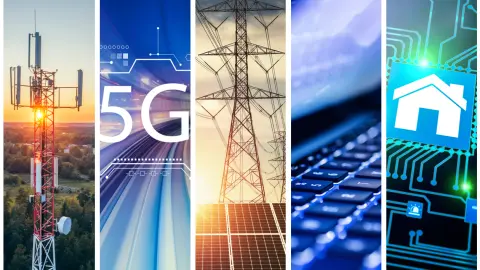European telecom sector faces additional regulation
The already densely regulated European telecoms sector faces three new regulatory packages, but the playing field between technology companies and telecom operators might also be levelled
The state of current telecom regulation
The European telecom sector is one of the most densely regulated sectors in the European Union. The most comprehensive regulatory package is the EU Electronic Communications Code (EECC). The EECC aims to harmonise telecom regulations across EU member states. It covers a plethora of different topics. Examples are spectrum management, which aims to harmonise spectrum allocations and licensing conditions within the EU. The harmonisation of spectrum allocations should, in turn, facilitate the rollout of wireless communication services. The EECC also covers competition rules, consumer protection, and the promotion of high-speed broadband development.
Other European telecom regulations cover net neutrality, data protection (under the GDPR), the sharing of infrastructure and access, as well as prices of telecom services under the Universal Service Directive. Recently, the EU added the elimination of roaming charges within its borders to the list.
In contrast, the technology sector is less strictly regulated, especially when it comes to consumer data. The technology sector is, of course, subject to the same antitrust regulations, as well as the GDPR, but it can process consumer data much more freely than telecom operators. The proposed ePrivacy Regulation of the European Commission might soon level the playing field, while three new regulatory packages provide both challenges and opportunities.
The DMA could change the technological landscape
In previous years, the European Union agreed on three major regulatory initiatives covering the telecom sector (alongside other sectors). The first is the Digital Markets Act (DMA), which came into force in November 2022 and became applicable in May 2023. The aim of the DMA is the removal of market barriers created by so-called gatekeeper platforms. Gatekeepers have more than 45 million monthly users, operations in at least three EU member states, and have global turnover exceeding $7.9 billion (e.g. Google, Facebook, Amazon). The DMA could affect telecoms in several ways. Firstly, it might curtail the dominance of large tech companies. Secondly, the DMA contains interoperability requirements for core platform services. This means that gatekeeper platforms need to ensure that their calling and messaging services are compatible with those offered by other parties. This reduces the digital stronghold of large technology companies on digital communication and offers room for novel initiatives, which could be launched by telecom operators (e.g. RCS). Lastly, the DMA also affects M&A because it contains a provision that mandates the reporting of all digital sector-related and data-related M&A transactions to the European Commission. Moreover, it aims to prevent the combination of personal data from different services offered by the same platform (e.g. YouTube and Google Search). Combined with the interoperability requirements, this will make M&A more complex for telecoms.
The DSA will increase content moderation costs
The Digital Services Act (DSA) aims to regulate digital services and online platforms in particular. It primarily takes aim at illegal content and disinformation, as well as transparency of data and algorithms used. It was approved in October of 2022 and came into effect in August of 2023 for very large online platforms and search engines. Digital service providers need to comply from January of this year. The DSA affects telecom companies in several ways. Firstly, the DSA states that companies hosting the data of others are liable when informed that this data is illegal. This affects telecoms that operate platforms where content is shared and it affects telecoms that offer hosting services. Secondly, companies that operate or host online platforms and services need to be transparent about their content moderation practices. This includes their decision-making practices around the removal of content, and their algorithms concerning content recommendation and advertising practices. In short, companies hosting data or operating online platforms need to ramp up their content moderation efforts.
The implementation of the AI Act might come with increased compliance costs
The AI Act is the first regulatory package of its kind. It aims to increase transparency, trust, consumer protection and fundamental rights where artificial intelligence applications are concerned. The cornerstone of the regulatory package is the division of AI applications in risk categories: higher risk applications are regulated more strictly than lower risk applications. The provisional version was agreed upon in December 2023 and it should apply from January 2026 onwards. Naturally, if telecom companies were to introduce AI applications then they may need to adapt the development, monitoring and deployment of those applications (e.g. in customer service) following the AI Act. Furthermore, companies need to carry out risk assessments of their AI systems which increases costs. In addition, strict European rules on AI will likely incentivise European telecom companies to make diligent choices on how they implement AI.
The ePrivacy regulation might level the playing field
The proposal for the ePrivacy Regulation was adopted by the European Commission in 2017. It is currently subject to interinstitutional European negotiations. If the proposed measures are agreed upon, then the playing field between telecom operators and technology companies will be levelled from a regulation standpoint. It currently includes provisions that will require so-called ‘new players’ (like Whatsapp or Skype) to offer the same privacy during (online) calls as telecom operators. In addition, it proposes to guarantee privacy on communications content and metadata, and can no longer be used by technology companies without user consent. This would offer an opportunity for telecom operators because the opt-in also applies to them. Currently, they cannot use any metadata, but if consumers give their consent they can. This could, for instance, result in the creation of heat maps that could aid transportation or public authorities. In short, the ePrivacy regulation in its current form looks fair, which would be good news for telecom operators.
More regulation to follow?
Currently, the European Commission is exploring two other major regulatory initiatives. The first is the Digital Networks Act (DNA). European Commissioner for the Internal Market Thierry Breton presented the core proposals of the DNA at the end of last year, although European elections are on the agenda for November of this year. The DNA updates many telecom regulations, but also supports the creation of so-called EU telecom ‘champions’. Breton wrote in October 2023 that telecoms need both scale and agility, but that current European market fragmentation holds them back. Removing national boundaries might thus foster cross-border M&A and create pan-European telecoms with more scope for large investment. If this were to happen, the DMA that was mentioned earlier will likely not prevent cross-border M&A because, for very large transactions, additional compliance costs will likely be overcome. This was celebrated by large telecoms, yet an uptick in cross-border deals is not expected in the near future. Compared to the US, the EU has a huge number of telecom companies, yet its consumers pay less and get better services.
The second major initiative being explored is whether or not the European Commission should propose making so-called ‘big streamers’ pay for the next generation of internet infrastructure. Some telecoms have argued that they foot the bill for large amounts of traffic generated by content providers such as Netflix and YouTube. Yet, others argue that this would violate net neutrality and that costs for telecoms do not increase with an increase in data traffic. It remains to be seen how the European Commission will proceed, but this will remain an interesting topic to follow in 2024.
In sum, a lot has happened in telecom regulation in the past years. This will provide telecoms with a few challenges in the years to come, but it might also level the playing field between technology companies and telecom operators.
This publication has been prepared by ING solely for information purposes irrespective of a particular user's means, financial situation or investment objectives. The information does not constitute investment recommendation, and nor is it investment, legal or tax advice or an offer or solicitation to purchase or sell any financial instrument. Read more
Download
Download article
1 February 2024
Telecoms Outlook 2024: Stepping into the future This bundle contains 8 Articles
